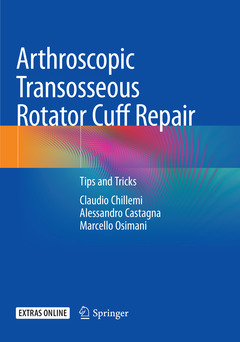Description
Arthroscopic Transosseous Rotator Cuff Repair, Softcover reprint of the original 1st ed. 2018
Tips and Tricks
Authors: Chillemi Claudio, Castagna Alessandro, Osimani Marcello
Language: English
Subjects for Arthroscopic Transosseous Rotator Cuff Repair:
94.94 €
In Print (Delivery period: 15 days).
Add to cartPublication date: 12-2018
Support: Print on demand
105.49 €
In Print (Delivery period: 15 days).
Add to cartPublication date: 07-2018
Support: Print on demand
Description
/li>Contents
/li>Biography
/li>Comment
/li>
Dr. Claudio Chillemi was graduated in Medicine and Surgery (110/110) in 1995 at the Catholic University of Sacred Heart in Rome and in 2000 completed his specialisation in Orthopedics and Traumatology (cum laude) at the University of Ancona. Working as an orthopaedic surgeon, he dedicated his basic research activity mainly to the elastic fibers system regulating the growing mechanism of long bones and to the tendon and cartilage healing processes. During the last decade his clinical research was centered to the shoulder pathology, focusing especially on arthroscopic technique. For this reason he partecipated to numerous international course and congresses and as a fellow, visited different European and American surgeons. He is actually member of the Italian Shoulder and Elbow Surgery Society (SICSeG) and of the European Society for Surgery of the Shoulder and the Elbow (SECEC - ESSSE). Every year he organizes different shoulder courses and hosts surgeons from all over the world interested in the shoulder field. He has presented original research at numerous orthopedic congresses and is the author of more than 40 publications in international journals. He currently works at Istituto Chirurgico Ortopedico Traumatologico (ICOT) in Latina, Italy.
Dr Alessandro Castagna is Responsible of the Shoulder and Elbow Surgical Unit at Humanitas Reasearch Hospital in Milan, Italy. After taking his degree at La Sapienza University, in Rome, he specialized in Orthopedics and Sports Medicine. He is Adjunt Professor at Milan University and he collaborated with many teaching institutions (L’Aquila University, Bologna and Perugia Universities). Over the last twenty years, his activity was mainly devoted to shoulder injuries, with special focus on mini-invasive surgical and arthroscopic techniques. Member of several scientific societies in the field, from 2012 to 2




